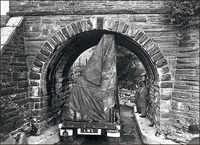
Churchill's wartime order to protect the nation's art - yet keep it in this country - meant quarries were blasted, roads were rebuilt and secret convoys of vans set off for Britain's most remote and secure outposts. Suzanne Bosman tells a tale of derring-do on the home front
On 23 August, 1939, the National Gallery was open as usual - but, as soon as the doors closed behind the last visitors, a well-orchestrated evacuation plan swung into operation. War was now imminent and the possibility that London might suffer saturation bombing meant that a new, safer home was needed for the paintings.
Over the next few days, the doors remained shut to the public while the paintings were removed from the walls and painstakingly loaded onto vehicles in conditions of strict secrecy. Vans bearing oddly shaped loads drove through the streets of London towards goods stations, where the crates were transferred to trains for their journey from London. About 1,800 works earmarked for evacuation had left London by 2 September, the day before war was declared.
When zeppelin raids had threatened London in the First World War, National Gallery works had been sheltered in the Aldwych tunnel of the Underground. It was recognised that more wide-ranging evacuation arrangements would be needed in the event of another war, and in 1934, the owners of selected stately homes were consulted as to whether they might store the paintings in an emergency.
Most of the houses were to the north-west and west of London, within relatively easy reach (including Waddesdon Manor and Stowe House, in Buckinghamshire, Bowood House, Wiltshire, and Buscot Park, Oxfordshire). However, in 1938, with international tensions rising, the gallery authorities rethought the matter and a plan was drawn up for the paintings to be evacuated farther afield, to Wales, where it was hoped they would be well out of harm's way.
In September 1938, during the Munich crisis, the assistant keeper, Martin Davies, made an exhaustive tour of country houses to assess their suitability for wartime storage. Davies made extensive notes on the physical statistics of the houses he visited, coupled with witheringly frank comments on some of the owners: 'The owner is nice, ruled by his wife, a tartar, anxious to have NG pictures instead of refugees or worse,' and, 'Owner not inspected but seems obliging in a haughty way.' ?Very few houses could meet all the requirements.
The pictures would have to be carried, so a minimum number of steps was essential: doorways had to be high enough to accommodate the largest paintings, and the rooms needed to be fireproof, of adequate size and with the right level of humidity. Accommodation for guards was needed as well.
One house that did meet the requirements was Penrhyn Castle, near Bangor. A huge neo-Norman fantasy constructed in the early 19th century, it had all the necessary features. Davies commented in his notebook, 'The building as a whole is extraordinarily massive.'
In late August 1939, the majority of the National Gallery's paintings were taken by train and van to Bangor, Aberystwyth and Penrhyn Castle. Others were stored in Caernarvon Castle, Plas-y-Bryn, at Bontnewydd, and Crosswood, near Aberystwyth. Some remained at Avening, in Gloucestershire, at the home of Lord Lee of Fareham, a gallery trustee. The many scattered locations and their vagaries were a considerable headache for Davies, who oversaw the whole operation.
At Crosswood, where 70 paintings were stored, the hot-water pipes of the antiquated heating system ran under the floor of the library, where the pictures were kept, seriously lowering the relative humidity, with potentially disastrous consequences for paintings on panel and canvas. As the heating could not be turned off without affecting the rest of the house, blankets and felt had to be soaked in a nearby stream and hung in the library until the humidity reached acceptable levels.
At Penrhyn, the paintings were housed all over the castle and the owner was a hazard in himself. In a letter to the keeper, William Gibson, Davies confided: 'For your most secret ear, one of our troubles at Penrhyn Castle is that the owner is celebrating the war by being fairly constantly drunk. He stumbled with a dog into the dining-room a few days ago; this will not happen again. Yesterday, he smashed up his car, and, I believe, himself a little - so perhaps the problem has solved itself for the moment.'
In June 1940, France fell, and in Paris German troops marched down the Champs Elysees. Hitler now turned his attention towards England. With invasion threatening, further measures needed to be taken. Indeed, there was strong pressure from many quarters for the collection to be evacuated to Canada. Kenneth Clark, the gallery's director, was unhappy with that proposal and, given the number of ships being torpedoed in the Atlantic, his fears were well founded.
 Churchill's wartime order to protect the nation's art - yet keep it in this country - meant quarries were blasted, roads were rebuilt and secret convoys of vans set off for Britain's most remote and secure outposts. Suzanne Bosman tells a tale of derring-do on the home front
Churchill's wartime order to protect the nation's art - yet keep it in this country - meant quarries were blasted, roads were rebuilt and secret convoys of vans set off for Britain's most remote and secure outposts. Suzanne Bosman tells a tale of derring-do on the home front